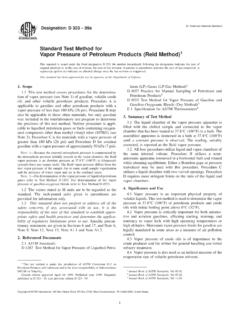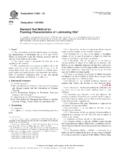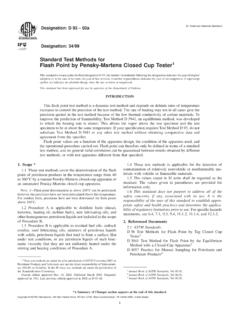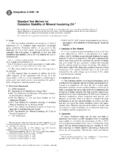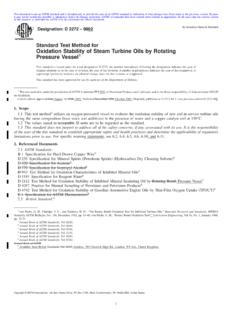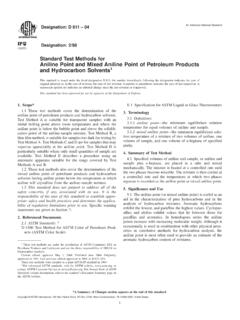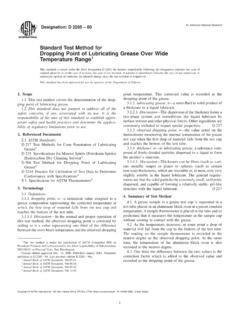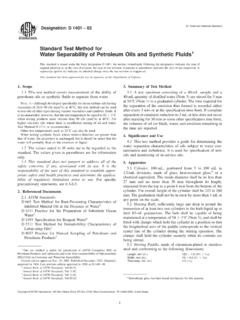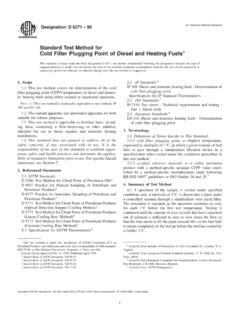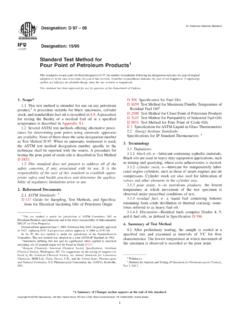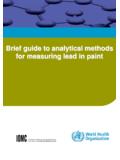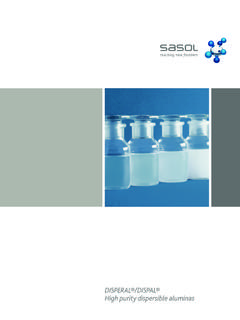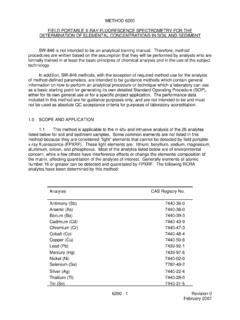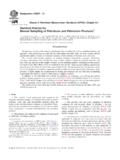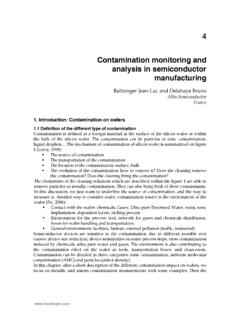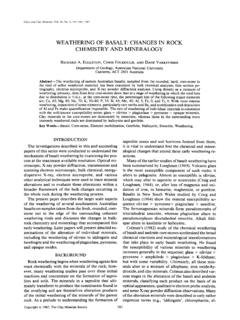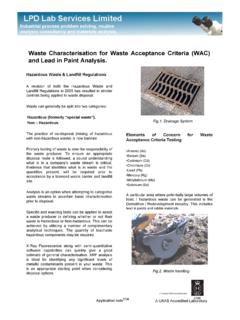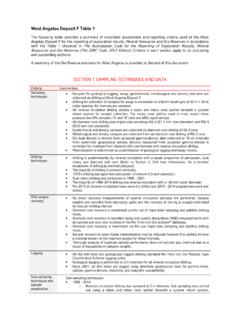Transcription of Designation: D 4294 – 03 An American National …
1 Designation: D 4294 03An American National StandardStandard Test Method forSulfur in Petroleum and Petroleum Products by Energy-Dispersive X-ray fluorescence Spectrometry1 This standard is issued under the fixed designation D 4294; the number immediately following the designation indicates the year oforiginal adoption or, in the case of revision, the year of last revision. A number in parentheses indicates the year of last reapproval. Asuperscript epsilon (e) indicates an editorial change since the last revision or standard has been approved for use by agencies of the Department of Scope* This test method covers the measurement of sulfur inhydrocarbons, such as diesel, naphtha, kerosine, residuals,lubricating base oils, hydraulic oils, jet fuels, crude oils,gasoline (all unleaded), and other distillates. In addition, sulfurin other products, such as M-85 and M-100, may be analyzedusing this technique.
2 The applicable concentration range to mass % The values stated in SI units are to be regarded as thestandard. The preferred concentration units are mass % standard does not purport to address all of thesafety concerns, if any, associated with its use. It is theresponsibility of the user of this standard to establish appro-priate safety and health practices and determine the applica-bility of regulatory limitations prior to specificwarning statements, see Section Referenced standards :2D 3120 Test Method for Trace Quantities of Sulfur in LightLiquid Petroleum Hydrocarbons by Oxidative Microcou-lometryD 4057 Practice for Manual Sampling of Petroleum andPetroleum ProductsD 4177 Practice for Automatic Sampling of Petroleum andPetroleum ProductsE 29 Practice for Using Significant Digits in Test Data toDetermine Conformance with Specifications3.
3 Summary of Test The sample is placed in the beam emitted from an X-raysource. The resultant excited characteristicXradiation ismeasured, and the accumulated count is compared with countsfrom previously prepared calibration standards that bracket thesample concentration range of interest to obtain the sulfurconcentration in mass %.4. Significance and This test method provides rapid and precise measure-ment of total sulfur in petroleum products with a minimum ofsample preparation. A typical analysis time is 2 to 4 min The quality of many petroleum products is related to theamount of sulfur present. Knowledge of sulfur concentration isnecessary for processing purposes. There are also regulationspromulgated in federal, state, and local agencies that restrictthe amount of sulfur present in some This test method provides a means of compliance withspecifications or limits set by regulations for sulfur content ofpetroleum If this test method is applied to petroleum matrices withsignificantly different composition than the white oil calibra-tion materials specified in this test method, the cautions andrecommendations in Section 5 should be observed wheninterpreting the Compared to other test methods for sulfur determina-tion, Test Method D 4294 has high throughput, minimal samplepreparation, good precision, and is capable of determiningsulfur over a wide range of concentrations.
4 The equipmentspecified is in most cases less costly than that required foralternative methods. Consult the ASTM website2or ASTMS ubject Index3for names of alternative test Spectral interferences result when some sample compo-nent element or elements emit X-rays that the detector cannotresolve from sulfur X-ray emission. As a result, the linesproduce spectral peaks that overlap with each other. Spectralinterferences may arise from samples containing water, leadalkyls, silicon, phosphorus, calcium, potassium, and halides ifpresent at concentrations greater than one tenth of the mea-sured concentration of sulfur, or more than a few hundred1 This test method is under the jurisdiction of Committee D02 on PetroleumProducts and Lubricants and is the direct responsibility of Subcommittee onElemental edition approved Nov.
5 1, 2003. Published December 2003. Originallyapproved in 1983. Last previous edition approved in 2002 as D referenced ASTM standards , visit the ASTM website, , orcontact ASTM Customer Service at ForAnnual Book of ASTMS tandardsvolume information, refer to the standard s Document Summary page onthe ASTM Book of ASTM standards , Vol *A Summary of Changes section appears at the end of this ASTM International, 100 Barr Harbor Drive, PO Box C700, West Conshohocken, PA 19428-2959, United Follow the manufacturer s operating-guide to compensate for the Matrix effects are caused by concentration variations ofthe elements in a sample. These variations directly influenceX-ray absorption and change the measured intensity of eachelement. For example, performance enhancing additives, suchas oxygenates in gasoline, can affect the apparent sulfurreading.
6 These types of interferences are always present inX-ray fluorescence analysis and are completely unrelated tospectral Both types of interferences are compensated for incontemporary instruments with the use of built-in software. Itis recommended that these interferences be checked from timeto time and that the software corrections offered by themanufacturer not be accepted at face value. Corrections shouldbe verified for new M-85 and M-100 are fuels containing 85 and 100 %methanol, respectively. As such, they have a high oxygencontent, hence, absorption of sulfur Karadiation. Such fuelscan, however, be analyzed using this test method provided thatthe calibration standards are prepared to match the matrix ofthe sample. There may be a loss of sensitivity and repeatability, reproducibility, and bias obtained in this testmethod did not include M-85 and M-100 In general, petroleum materials with compositions thatvary from white oils as specified in may be analyzed withstandards made from base materials that are of the same, orsimilar, composition.
7 Thus, a gasoline may be simulated bymixingisooctane and toluene in a ratio that approximates thetrue aromatic content of the samples to be analyzed. Standardsmade from this simulated gasoline will produce results that aremore accurate than results obtained using white In the case of petroleum materials that contain suspendedwater, it is recommended that the water be removed before testing or thatthe sample be thoroughly homogenized and immediately tested. Theinterference is greatest if the water creates a layer over the transparent filmas it will attenuate the X-ray intensity for sulfur. One such method toaccomplish the removal of water is to centrifuge the sample first underambient sealed conditions, taking care that the sample integrity is X-ray fluorescence Analyzer Anyenergy dispersive X-ray fluorescence analyzer may be used ifits design incorporates, as a minimum, the following of X-ray Excitation, X-ray source with energyabove keV.
8 (Warning In addition to other precautions, ifa radioactive source is used, it must be well shielded tointernational standard requirements and, therefore, not presentany safety hazard. However, attention to the source is only tobe carried out by a fully trained and competent person using thecorrect shielding techniques.)NOTE2 Operation of analyzers using X-ray tube sources is to beconducted in accordance with the manufacturer s safety instructions andlocal Cell, providing a sample depth of at least 4mm and equipped with a replaceable X-ray transparent plasticfilm Detector, with sensitivity at keV and aresolution value not to exceed 800 eV. A gas filled proportionalcounter has been found to be suitable to , or other means of discriminating betweensulfur Karadiation and other X-rays of higher Signal conditioning and data handling electronics thatinclude the functions of X-ray intensity counting, a minimumof two energy regions (to correct for background X-rays),spectral overlap corrections, and conversion of sulfur X-rayintensity into percent sulfur or Printer, that reads out in mass % Reagents and of Reagents Reagent grade chemicals shall beused in all tests.
9 Unless otherwise indicated, it is intended thatall reagents conform to the specifications of the Committee onAnalytical Reagents of the American Chemical Society wheresuch specifications are grades may be used,provided it is first ascertained that the reagent is of sufficientlyhigh purity to permit its use without lessening the accuracy ofthe Sulfide (DBS), a high purity standard with acertified analysis for sulfur content. Use the certified sulfurcontent when calculating the exact concentrations of thecalibration standards ( ). (Warning Di-n-butyl sulfide isflammable and toxic.)NOTE3 It is essential to know the concentration of the sulfur in thedi-n-butyl sulfide, not the purity, since impurities may also be sulfurcontaining Oil, White (MOW), ACS reagent grade or lessthan 2 mg/kg Transparent Film, any film that resists attack bythe sample, is free of sulfur, and is sufficiently X-ray transpar-ent may be used.
10 Films found to be suitable are polyester,polypropylene, polycarbonate, and polyimide Samples of high aromatic content may dissolve poly-ester and polycarbonate films. In these cases, other materialsbesides these films may be used for X-ray windows, providedthat they do not contain any elemental impurities. An optionalwindow material is polyimide foil. Although polyimide foilabsorbs sulfur X-rays more than other films, it may be apreferred window material as it is much more resistant tochemical attack by aromatics and exhibits higher Cells, resistant to sample attack and meetgeometry requirements of Sampling and Specimen Samples shall be taken in accordance with the instruc-tions in Practice D 4057 or D 4177, where Chemicals, American Chemical Society Specifications, AmericanChemical Society, Washington, DC.
